3-10 March 2014. Groaning our way out of bed at 3.30am we prepare for a 4.25 departure to Quito airport for the flight to Baltra to begin our cruise of the Galapagos Islands. At the airport we receive the sweet news that we’ve been upgraded from a porthole cabin to a ‘Junior Suite’ with big windows. On arrival at Baltra we have a long wait for a bus and a short ride to the dock. We clamber into a rubber dinghy and travel over choppy seas. The dinghy, bouncing rocking rolling on the rough water pulls up to the side of our ship. Men on board hold ropes to keep the dinghy close. Others reach out their hands to pull us up. One by one we find balance enough to step up onto the side of the dinghy and then onto the stairs, fiercely grabbing hold of hands and/or railings and pulling ourselves up the three or four steps onto the gently undulating deck of the ship. We have arrived at the beginning of our Galapagos adventure.
Our ‘Junior Suite’, home for the next eight days.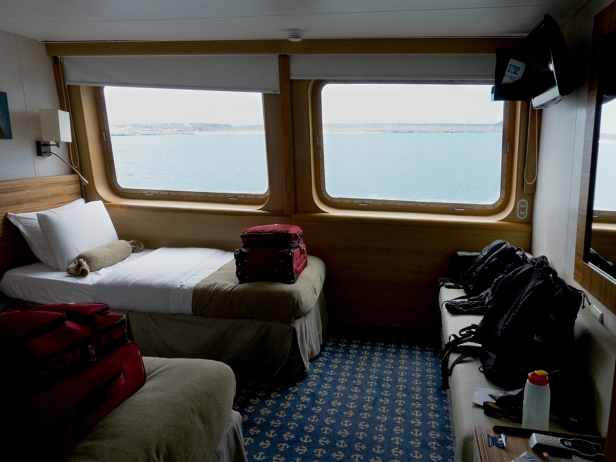
There is a great variety in the size and style of boats available to tour the islands. We wanted something stable so chose the largest, accommodating one hundred passengers, the maximum allowed, though there are only about sixty on this cruise. We have eight days of exploration ahead of us. But first an excellent buffet lunch, an introduction to the ship by the purser, an introduction to the islands by the head naturalist, emergency evacuation drill, and being fitted for snorkeling gear.
At last it is time. In small groups of about fifteen we climb back into the dinghies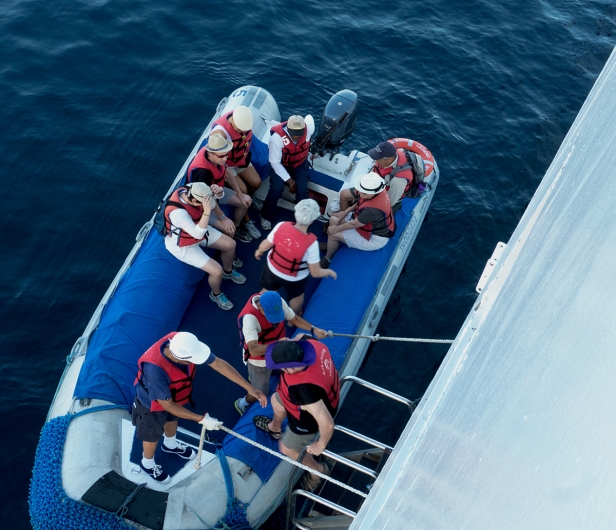
and depart at spaced intervals for the short ride to Mosquera Islet, slipping off the side of the dinghy into crystal clear waters and onto a long empty white sand beach. Empty except for hundreds of sea lions. We are amazed. The sea lions are indifferent to this invasion of other beings. They have never had reason to be afraid of humans so they serenely continue doing their sea lion thing: walking their lurching walk, rolling in the sand, barking, swimming, rolling in the waves, pups suckling or mewing for mum. They are stacked up side by side, rolling around and on top of each other, playing together, soaking up the sun and the water, completely at one with their environment and oblivious to us.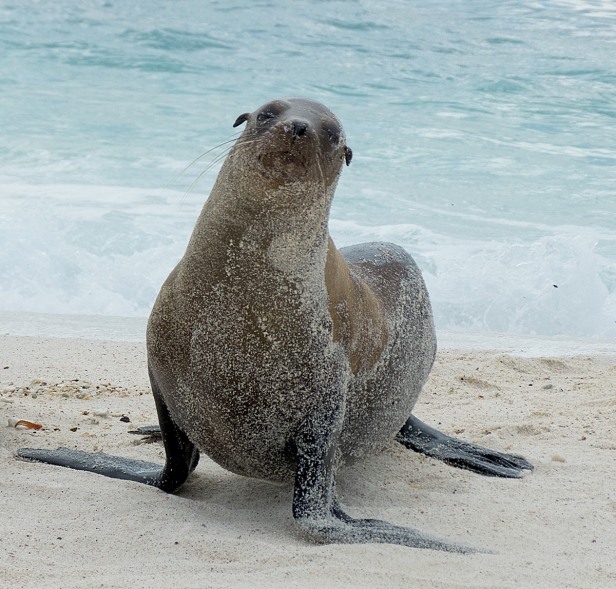
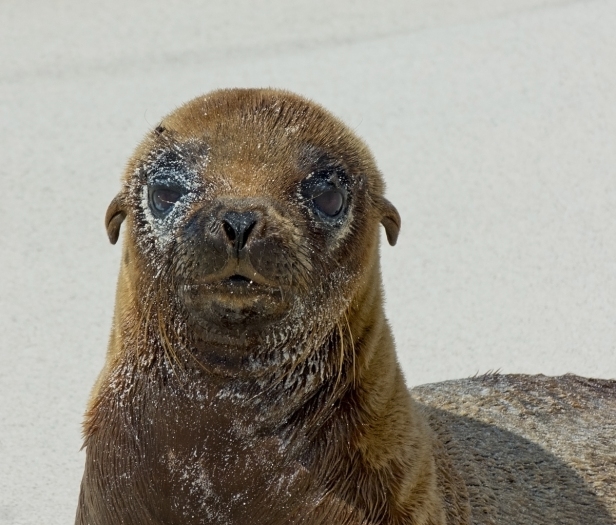
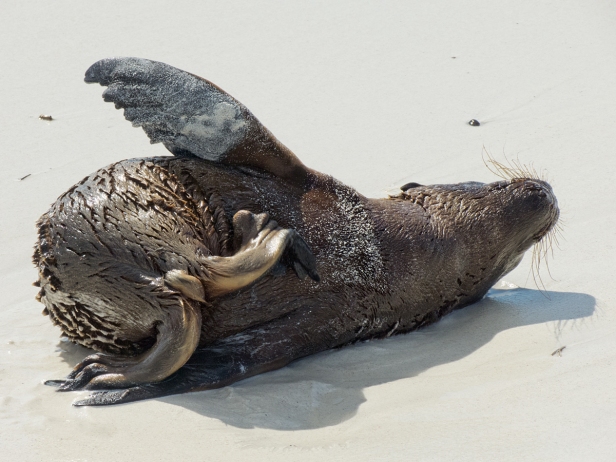
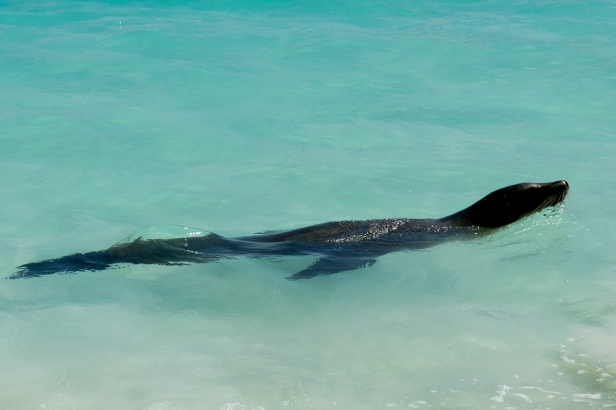
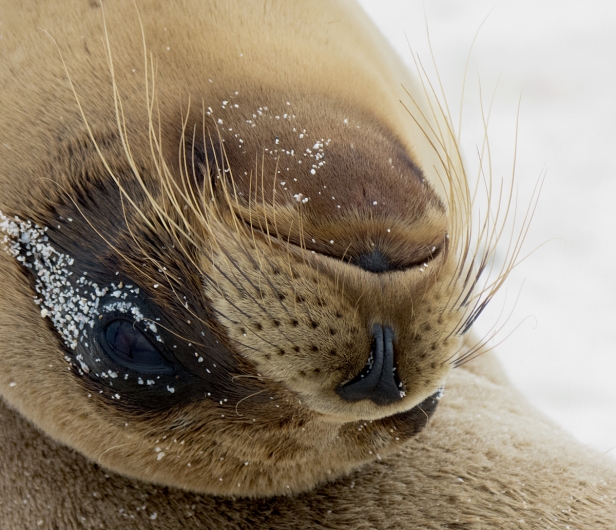
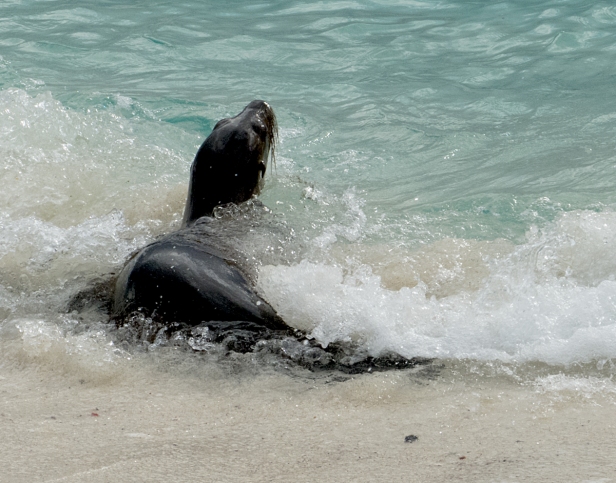
And on the groups of lava rocks dotted here and there along the edge of the water are marine iguanas and the wondrously colourful Sally Lightfoot crabs. Dozens of iguanas and hundreds of crabs crawling floundering swarming all over each other, clinging precariously to the rocks as the waves crash over them, until there is a wave so big that it washes them all off into the sea.



The Galapagos, a volcanic archipelago straddling the equator, consists of 19 islands and over 100 rocks and islets. It lies about 1000 kilometres off the west coast of South America and is a province of Ecuador, a national park, and a biological marine reserve. There are four towns, each on a different island, with a total population of something over 25,000. On the plus side tourism is strictly controlled with visitors given access to only 54 land sites and 62 diving and snorkeling sites. The National Park sets all the cruise itineraries so no two boats are at the same place at the same time. Small groups are allowed to visit each site for only two to four hours and must be accompanied by a licensed guide. On the minus side people have been visiting these islands on and off, attempting various settlements, whalers provisioning their ships, Ecuador sending its prisoners, ever since they were first ‘discovered’ in the 1500’s. They all brought with them many plants and animals not native to the islands that have flourished and are of severe environmental concern.
Of course I cannot write a post about the Galapagos and not include a mention of Charles Darwin who first landed here on 15 September 1835. He was on board the survey ship HMS Beagle. He noticed that the mockingbirds differed between the islands, and was also made aware that the same was true for the tortoises. He took many specimens of birds back to England, but it was only after John Gould, the famous English ornithologist, had studied them that Darwin understood their significance. Gould showed that finches too differed from island to island each developing, like the mockingbirds and tortoises, according to their own particular and unique circumstances. This information was critical to the development of Darwin’s theory of natural selection as the guiding principle of evolution. The publication of The Origin of the Species in 1859 was hugely controversial at the time, flying in the face, as it did, of Christianity’s version of creation.
On board ship our days unfold in a steady rhythm: a hearty early breakfast followed by a trip by dinghy to an island where we go hiking and/or swimming and/or snorkeling always in close range of wildlife that has no concern for our presence. A sumptuous lunch followed by a rest then another outing to a different island, followed by a four-course dinner with the wonderful company of two American couples and a couple from Taiwan. There is always after-dinner entertainment but we usually entertain ourselves in our cabin with writing, reading, and sorting through the day’s photographs.
One day we see brightly coloured marine iguanas sunning on the rocks and swimming.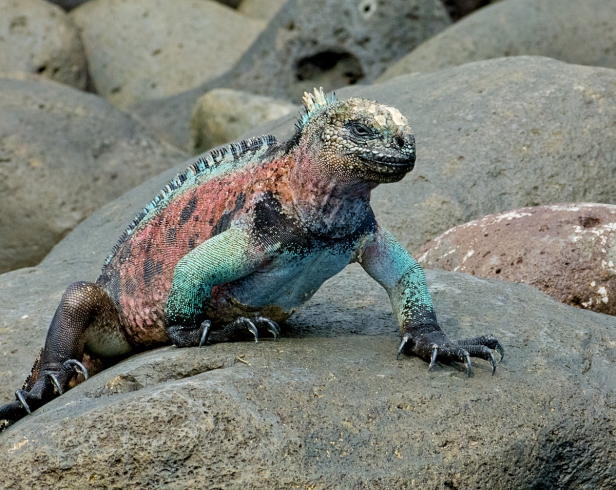

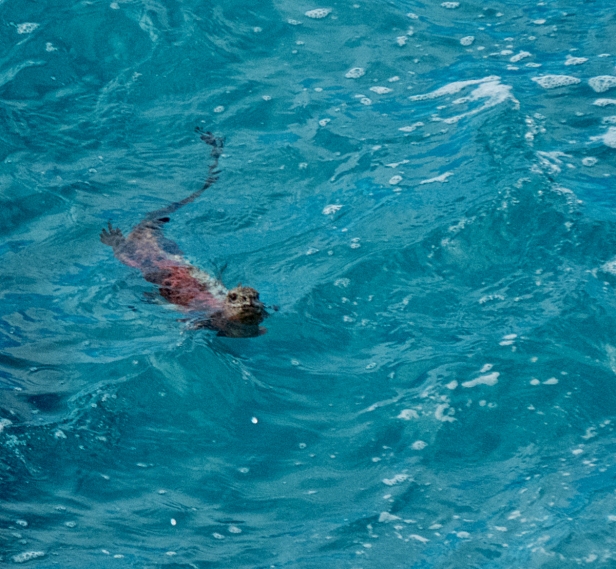
On another day, a single Sally Lightfoot crab in all its resplendent glory.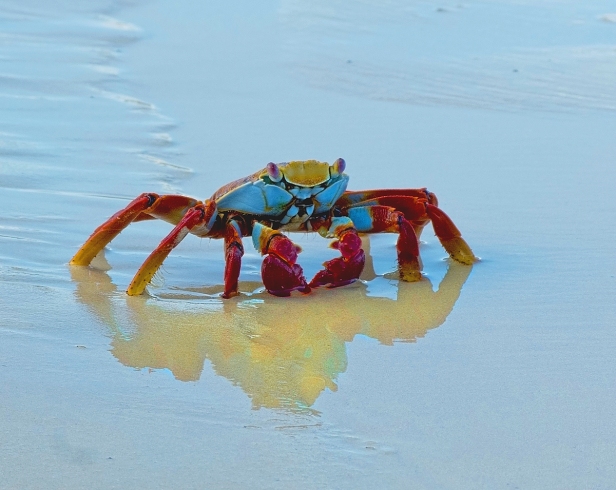
On South Plaza Island we hike through a cactus forest and are surrounded by land iguanas. The land iguanas feed on the cactus and are very territorial, each guarding its own tree. We see them again and again, on several different islands and in a great variety of colours.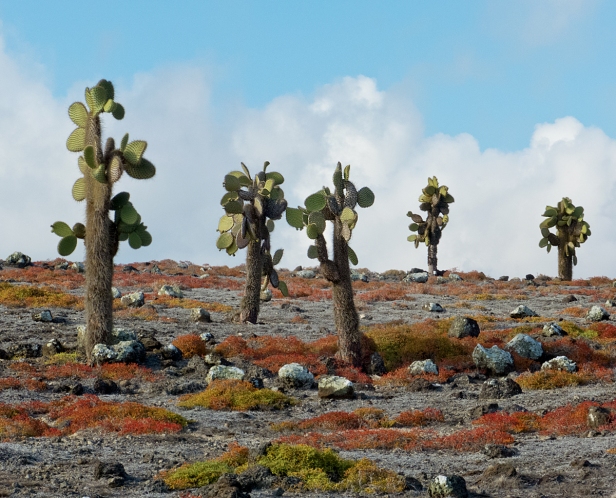

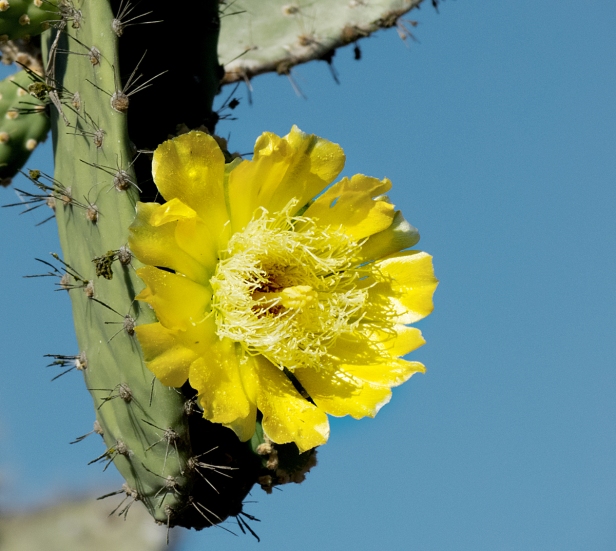

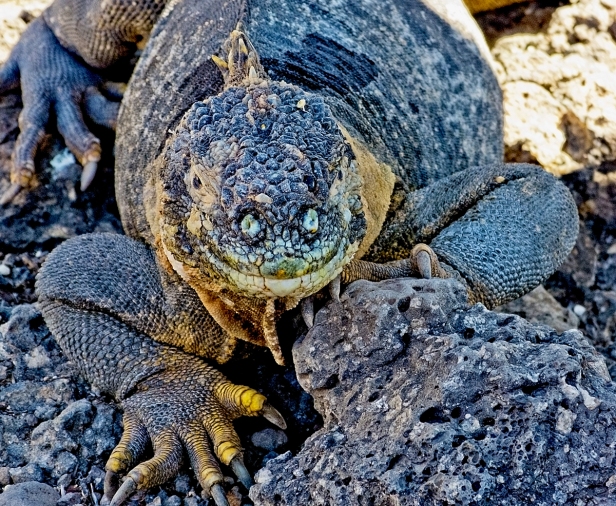
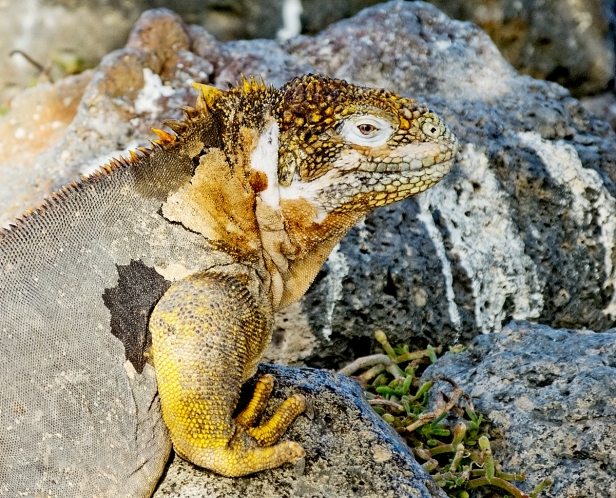
We see lava lizards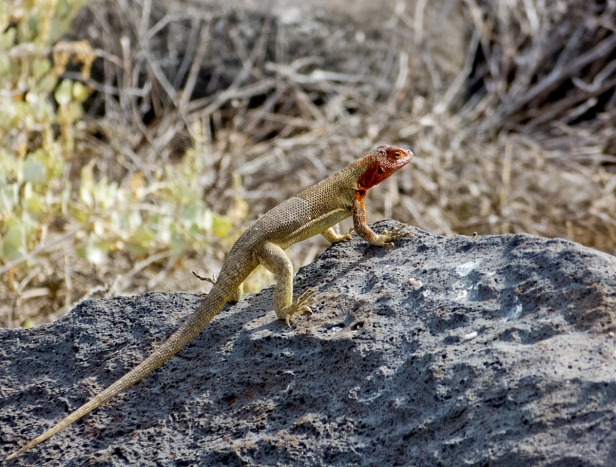
and there are sea lions on every island we go to.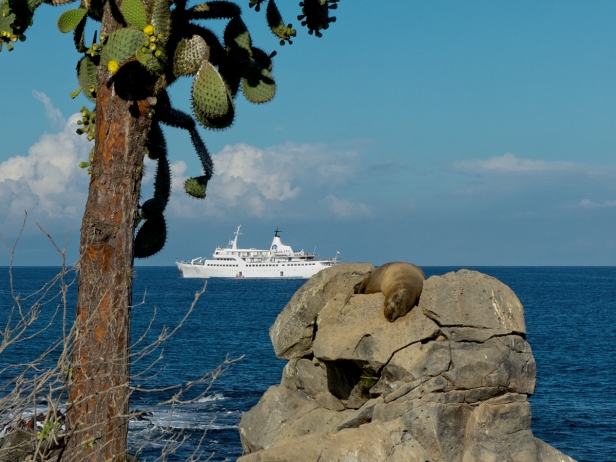

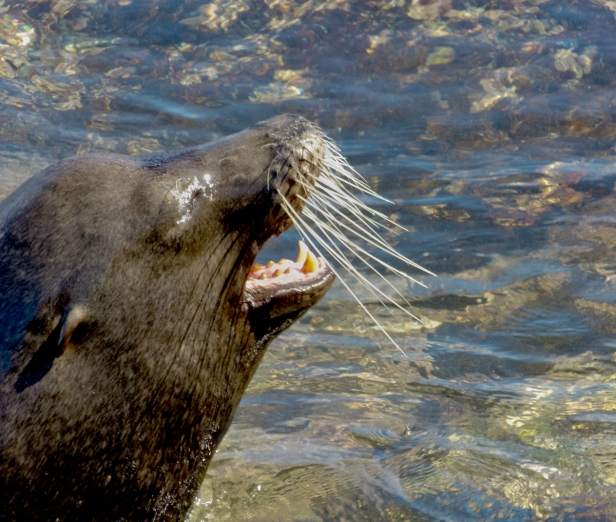
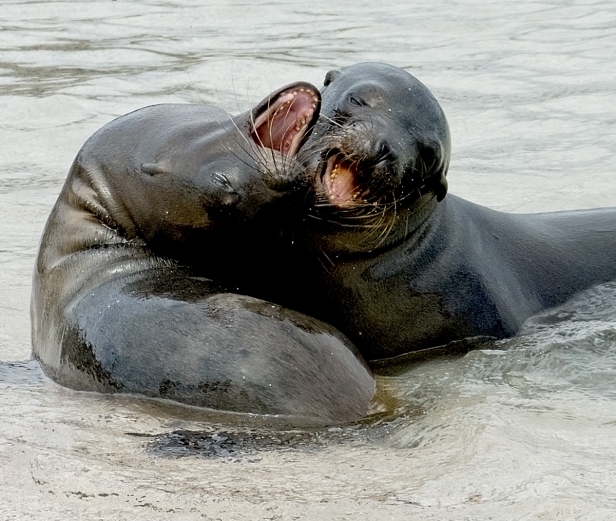


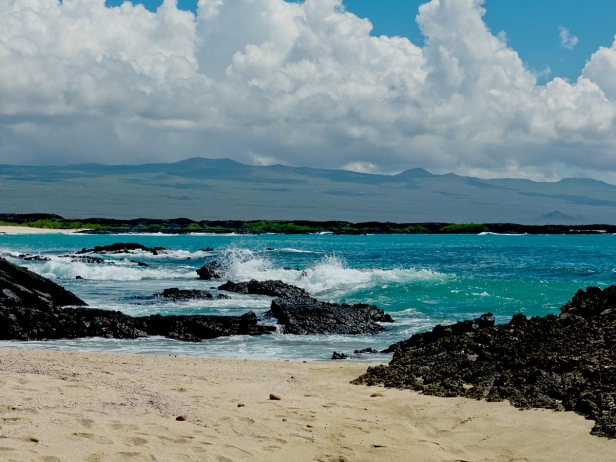
Some islands are little more than harsh rock, some are covered in low vegetation, some are forested.
Every evening there are dazzling sunsets.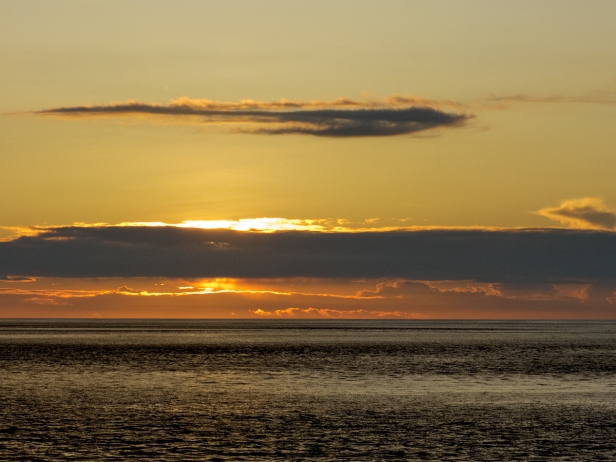
It is a magical time. Every day a new adventure. We are completely enraptured. We love ship-board life. We are astounded and seriously impressed by the detailed organization on the ship so that all our needs are met. We love the tropical climate and the warm clear waters. And we love most of all the close encounters with the untroubled, abundant, beguiling wildlife. It is a magical time.
Next post: Oh my goodness the bird life: blue-footed boobies, red-footed boobies, Nazca boobies, herons, frigates, pelicans, mockingbirds and swallowtail gulls. Snorkeling with turtles, sharks, dolphins and angelfish. And of course several encounters with the famous giant Galapagos tortoise.
We visited Mosquera Islet, and South Plaza, Santa Fe, San Cristobal, Española, Floreana, and Santa Cruz Islands. Our ship was the Galapagos Legend.
All words and images by Alison Louise Armstrong unless otherwise noted
© Alison Louise Armstrong and Adventures in Wonderland – a pilgrimage of the heart, 2010-2015.

Those crabs look delicious… Gorgeous photos, and what a spectacular trip!!!
LikeLike
Delicious?! Too funny. And too small to eat 🙂
Thanks Lu. It really was a spectacular trip.
LikeLike
Oh haha they looked so large in your photos! I hope I will get to go one day!
LikeLike
absolutely incredible!
LikeLike
Yeah, thanks. It really was. Quite extraordinary.
Alison
LikeLike
What a stunning series of photographs, Alison! I’m thrilled that the wildlife are so undisturbed by the presence of human visitors – it seems like you got very, very close to them. The Galapagos sound heavenly, although the cost of a trip there seems to hold a lot of people back. I’m really looking forward to your next post on the birds and giant tortoises… from your circuit of South America you’ve developed a knack for taking fantastic bird shots!
LikeLike
Thanks so much James. Yes, we did get very close to them. The rule is no closer than 6 feet but we did go closer of course from time to time. In the Nazca booby nesting colony they were nesting right by the trail so we had no choice. And the sea lions would come towards you so we’d back off if we could. The land iguanas would also walk right towards you – not deliberately so much as just going about their business and unconcerned by your presence.
There’s no doubt there’s no cheap way to see the Galapagos – just the cost of the airfare for a start, though once there it’s possible to stay in homestays and hostels and do day trips. Our cruise was about mid-range.
I think I got a few good shots of the birds – coming up 🙂
Alison
LikeLike
Stunning photographs! I’m planning on “doing” Ecuador within the next year (currently in SEA) and would love some details on the ship you chose – name, price, etc. if you’re willing to share. Thanks!
LikeLike
Thanks Mary. The ship is Galapagos Legend, run by Klein Tours. I was going to put a link to their website but it appears to have been hacked by something Russian. Hopefully they will discover it soon and fix the problem.
We paid just over $4000 each and booked through http://www.galapagosislands.com
If you google Klein Tours you’ll get a link to their website, but I’m not sure I’d recommend it. It went to something Russian and I had to shut down the computer. Other than that it doesn’t seem to have done any harm. Fingers crossed. galapagosislands.com is fine and offers many alternatives for tours of the islands.
Alison
LikeLike
Forgot to say what we paid included return airfare from Quito.
LikeLike
Y-e-s-s-s-s-s-s! I am immersed. Give me some smells. Did the sea lions stink like they do on the Oregon coast? The junior suite, views of the ocean through the windows, smell of salt water? Magical is an excellent word – it’s a magical world. Can’t wait for the next installment — I will be revisiting this one many times. Thank you, Alison.
LikeLike
Thanks so much Pam. Finally, eh! I never write about smells. I have a fairly weak sense of smell so it is not a sense that is foremost for me. Right in the background actually. However I can say that no, the sea lions weren’t stinky. And yes, endless smell of saltwater though not through the sealed windows of our cabin. Magical. Spectacular. Heart-opening. Thrilling. And more. So glad you enjoyed the post.
Alison
LikeLike
I’ve been fascinated with Darwin ever since learning about him during school days – gotta love a guy who traveled around in The Beagle! The Galapagos area strikes me as a sort of Jurassic Park – a place lost in time. (Although you did note the encroachment of non-native plants and non-native humans.) Observing animals without the fear-of-humans barrier would be a treat. I will never go there personally – serious motion sickness issues on the ocean – your photo/description of travel via dinghy – ugh. You and Don really travelled for me on this one.
LikeLike
It is a kind of Jurassic Park, and they’re doing all they can to preserve it.
LikeLike
Looks incredible! I couldn’t afford the Galapagos on our backpacker budget this time around but will definitely visit there in the future
LikeLike
Yes, incredible. And when I was in my twenties travelling in Sth America I couldn’t afford it either, but do go in the future. It really is special.
Alison
LikeLike
Thanks for taking us along with you on this amazing adventure. I love the pictures and can’t wait for more.
LikeLike
Thanks Darlene, and you’re welcome. Glad you’re enjoying the journey 🙂
Alison
LikeLike
That was truly was an incredible read and visual, Alison! Beautifully captured photos.
LikeLike
Thank you so much. It’s a really extraordinary place. I feel so fortunate to have been able t go there.
LikeLike
Oh, Alison, you have outdone yourself this time.
A question about the lizards: how big are they? In the close-up photos it was hard to tell.
LikeLike
Thanks Fiona. It’s such an amazing place. Everyday we were completely gobsmacked! The lizards are only about 5″ in the body, and another 5 of tail. The iguanas are bigger and fatter – 3 to 5 feet with body weight of up to 25lbs.
LikeLike
Gorgeaus pictures, I need to plan to go to Galapagos to see them myself….
LikeLike
Thanks Nina. Do go! It’s really extraordinary.
LikeLike
My heroes…again!!!
LikeLike
Thanks so much Keith 🙂
We just might show up in Bali next March/April – are you likely to be there?
Alison
LikeLike
Another gem of a post Alison 🙂
Incredible images and beautiful write up.
I haven’t seen such colorful crabs in my life.
I am sure you guys had a great time 🙂
Thanks a lot for sharing.
LikeLike
Thank you Sreejith. Yes, we did have a great time – really special. And so are those crabs! I hadn’t seen anything like them either.
LikeLike
What a wonderful trip. Great photos! ❤
LikeLike
Thanks Paulette. Yes, it really was a wonderful trip. Definitely one of the highlights of South America.
LikeLike
Finally! I’ve been waiting to go with you to the Galapagos for months. 🙂 What an incredibly vibrant place – the colors, the wildlife, the decadence of your tour. I can’t afford the islands yet on my budget either, but your photos are moving it upwards on my bucket list. And in the meantime, I get to look forward to your next post!
LikeLike
It is an incredibly vibrant place, and definitely must go on your bucket list! You can do it in a less expensive way than we did, but yes I confess we loved the decadence 🙂
LikeLike
Awesome photos. I can only dream of coming to the Galapagos! The cruises are expensive.
LikeLike
Thanks Lee. Yes the cruises are expensive but there are other ways – but no way around having to fly there. It may be less from Guayaquil than from Quito. Also there’s a $100 park entrance fee. Once on the islands there are 4 different towns you can stay in that I think have hostel/homestay accommodation and you can take day trips from the towns to different islands. I haven’t looked into the cost of doing it this way but I’m fairly sure it will be a lot less than what we did.
Alison
LikeLike
Drop dead gorgeous photography plus a great story. Doesn’t get any better you two. Am I allowed to be a little jealous? 🙂 –Curt
LikeLike
Thanks so much Curt. Yes, you’re allowed to be jealous 🙂 – but you two get yourselves to South America stat!
Alison
LikeLike
🙂
LikeLike
Alison as always your photos are stunning! We’ll have to seriously study our RTW budget and allow for the Galapagos!
LikeLike
Thank you so much Ginnette&Gordon. I really recommend going – it’s one of the most extraordinary and unique places on earth.
Alison
LikeLike
The pictures are amaaaazing! Absolutely brilliant. I loved this post. I’ve heard so much about the Galapagos Island, and this post corroborates all that. And oh, the sea lions! ❤ You captured some lovely moments there. 🙂
LikeLike
Thank you very much. I’m so glad you enjoyed it. The Galapagos were even better than we expected. A really fabulous experience.
Alison
LikeLike
This is amazing. I always wanted a perspective on Galapagos and I am so glad that I dropped by your blog. Thanks for such an interesting write-up with perfect images to support the same. 😀
LikeLike
Thanks sb. Thanks for dropping by, and for following. I’m glad you enjoyed the post. Galapagos really is amazing, a world unto itself, like no other place on earth.
Alison
LikeLike
I could never imagine that the island would have so many colours!! Just look at the crabs! 😀
LikeLike
Aren’t those crabs amazing?! We loved them. Also the blue-footed boobies coming up in the next post.
LikeLike
ohh!! please do update me as soom as you do that! Waiting in anticipation 🙂 hi5!
LikeLike
these photos are stunning. I have just started my blog about moving to Germany and after having seen these photos I have bought a much better camera to document like you 🙂 love this post, I live on a small island too but it looks a lot different.. ha!
LikeLike
Thank you so much Jennifer. Yeah, your island *is* a bit different lol.
I’m ready for a camera upgrade myself.
BTW you’ve made a great start on your blog.
Alison
LikeLike
Reblogged this on travelsofmo and commented:
Besides writing my own blog, I read as many other travel blogs as I can, which serves to inspire and make me jealous at the same time! One pair of adventurers, Alison and Don, constantly astound and amaze me. For your reading pleasure, here is the first part of their tale of visiting the magical and mysterious Galápagos Islands! (Complete with stunning photos, of course)
Good Luck and Happy Travels,
Mo
LikeLike
Thank you so much Mo. I really appreciate the reblog, and your kind words.
Happy travels to you too.
Alison
LikeLike
This post really made me miss the Galapagos Islands even more! This was the most amazing place I have been to. I was there for 3 weeks in 2008, I did a volunteer work in San Cristobal and also had some time off to travel around other islands. I will never forget that experience 😀 thanks for reminding of some amazing things this place offers. Your pictures are just AMAZING! 😀
LikeLike
Thanks so much re the photos. Three weeks there! How wonderful. I imagine it must have been an incredible experience. I’d love to have 3 weeks there. Still I realise we’re hugely blessed to even get there at all so I will not complain!
Alison
LikeLike
Yes Alison, you are blessed for getting there, everyone that has the incredible opportunity to visit the Galapagos is blessed. Its such an amazing place… 3 weeks were still not enough, but Im also not going to complain 😀 maybe you can go back and spend more time someday! Best, Allane
LikeLike
Those marine iguanas on the rock seem to have the faces of ancient beings who decided to hang out on a tropical island and soak up the good life for a while. They definitely seem to know something I don’t. They crack me up on the one hand, as they look like a big pile of selfless, utterly pure, hair-trigger, take-one-more-step-and-see-what-happens intensity who simultaneously couldn’t be bothered by the crabs crawling all over them. But a couple of those close-ups wound me on the other hand. The eyes seem old, ancient, pensive, enduring. Amazing.
Michael
LikeLike
Oh I love your description of the marine iguanas. It’s exactly right – a don’t mess with me attitude coupled with a huge pensive ancient wisdom. And the crabs are beneath their notice 🙂
Alison
LikeLike
Unreal! You are so blessed.
LikeLike
Yes, you are right, we are so blessed.
LikeLike
Beautiful photos Alison. The crabs are fabulous. I envy your trip to the islands. We’ve had it on our list for years, but as you know, it’s not a place one just drops by. I also liked hearing some of the logistical aspects of your trip. ~James
LikeLike
Thanks James. Aren’t those crabs wonderful?! Oh go on – just drop by! It’s only a flight to Quito then one to Baltra 🙂
The logistics for the cruise we chose were fine tuned to the last detail. There are smaller boats, and because the itineraries and access points are so controlled I imagine it would be the same with them.
Alison
LikeLike
Thanks for the wonderful post! I particularly enjoyed the photos of the multi-colored iguanas. Who knew that iguanas came in colors like the rainbow? It sounds like a fantastic trip.
LikeLike
Thank you so much. We were surprised by the iguanas too – so much unexpected colour. And yes, it was a fantastic trip; extraordinary in so many ways.
LikeLike
This was even more incredible than I thought it would be – what an immensely exotic place. The variety of lizards are amazing and the crabs are just gorgeous – never thought I’d say that about a crab!
Amazing tour, photos and experience!
~ Andrea ❤
LikeLike
Thanks Andrea. Isn’t it all amazing?! We were totally blown away. I love the crabs – such beautiful colours.
Alison
LikeLike
I have never heard of Galapagos..this post is very informative for me..all pics are amazing..thank you Alison for sharing..i really enjoy reading it…
LikeLike
Thanks so much Alisha, and you’re welcome. Glapagos has been on my list for about 30 years. I think I first heard of it in my 20’s on my first visit to Sth America but couldn’t afford to go then.
The next post is about Galapagos too.
Alison
LikeLike
Your photos are magnifique! And the travelogue is fascinating!
LikeLike
Thank you so much Cindy
A.
LikeLike
This is amazing! Now I can’t get the ‘junior suite’ off my mind… and that view! Thanks a lot for posting this! 😉
LikeLike
You’re welcome. Isn’t it fabulous?! We were so totally gobsmacked by everything we saw. The trip of a lifetime for sure.
LikeLike
I’ve watched some documentaries about Galapagos, but always thought they just had great video editors since it’s too beautiful to be real :))
LikeLike
It really is beautiful. And the unafraid wildlife something you couldn’t imagine. We’ve heard there’s an IMAX movie of Galapagos – on the lookout for it. Would love to see it.
LikeLike
Lovely photography and the words match perfectly as well!
LikeLike
Thank you so much. It’s a magical place, you must go!
Alison
LikeLike
I’ve always wanted to visit the Galapagos and this post has reaffirmed that. Your photos are stunning and the stateroom you had looks lovely!
LikeLiked by 1 person
Thanks so much Kristina. The Galapagos Islands are truly amazing. Definitely worth going to. I hope you get there one day!
Alison
LikeLike
This is certainly the ultimate bucketlist destination and your photos and words certainly brought it to life. What an experience and privilege to have visited the Galapagos islands! I can but only dream!
LikeLiked by 1 person
Thanks Angie. It was an amazing experience and I’m so glad we did it regardless of cost. I hope you get there one day! Totally worth it.
Alison
LikeLike